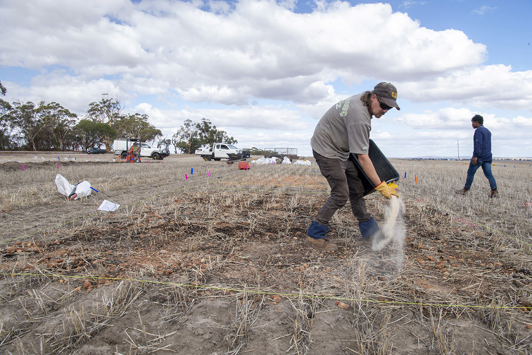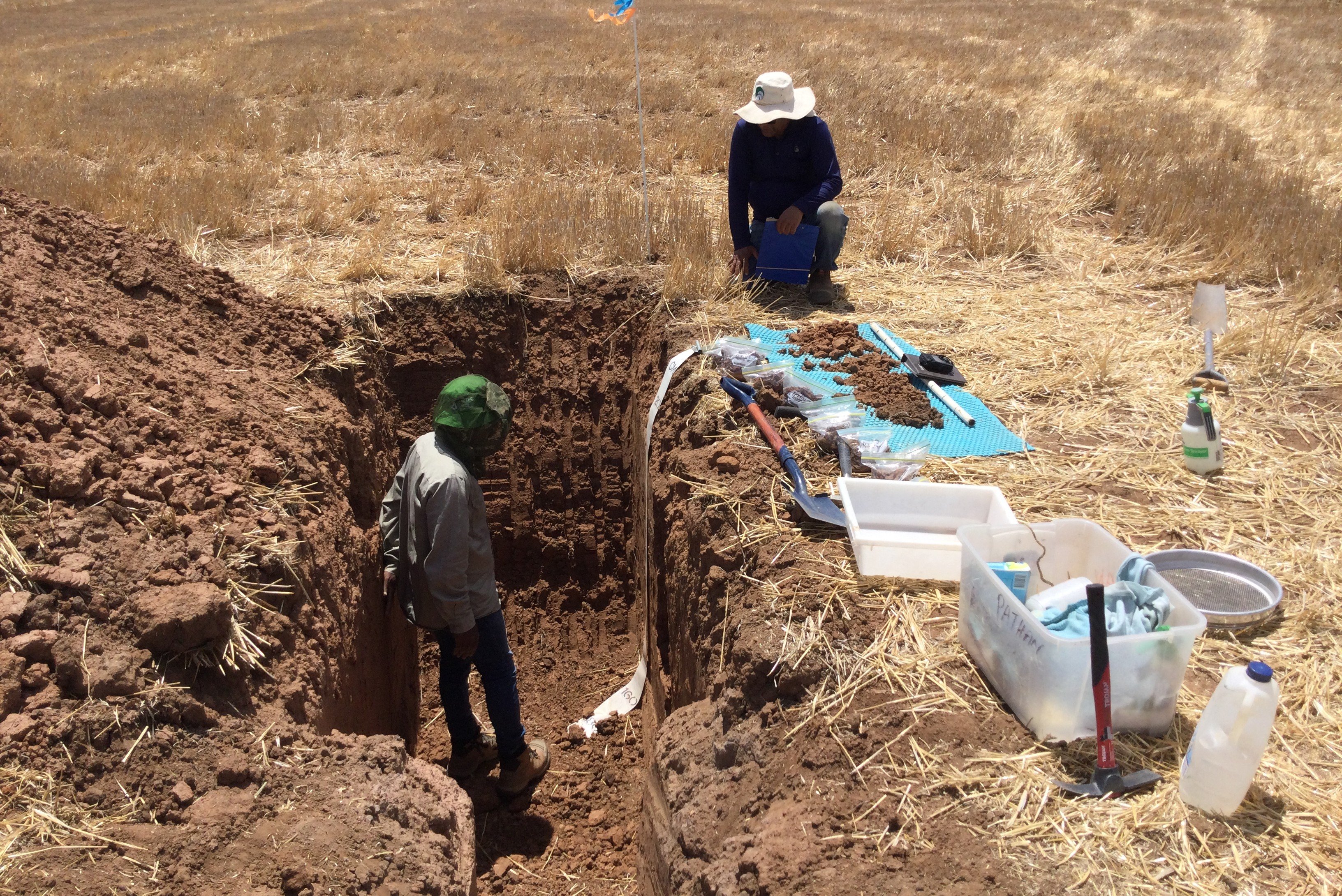
Research priorities
- Soil amelioration
- Soil re-engineering
- Sodic soils
- Post-amelioration management
- Crop nutrition
Priority projects
The department and the Grains Research and Development Corporation (GRDC) have entered into a 5-year strategic research collaboration with the aim of transforming water and nutrient use efficiency in WA grain production. Known as the SWAN (Soil Water and Nutrition) strategic collaboration, the department is investing $29.2 million, together with $26.7 million from GRDC.
State date: 01/07/2024
Finish date: 30/06/2029
Description
More than 85% of WA grain growers are actively improving their soils and about two-thirds of growers use deep soil tillage strategies, of which most are incorporating lime or gypsum. In addition, around 20% of WA growers regularly use lime or gypsum, without deep tillage.
The SWAN partnership will investigate how deeper soil improvement - known as soil profile re-engineering - coupled with tailored crop nutrition, crop rotation and agronomic management can achieve further gains in water use efficiency and grain production. With the aim of achieving a step-change increase in crop water use efficiency and grain yield.
The initiative will build on 15 years of DPIRD soil improvement research, which shows deep mixing the soil and incorporating lime, gypsum, organic matter or clay improves crop water use efficiency and grain yields up to four-fold.
The project aims to help future-proof WA’s grains industry to support growers adapt to a drying climate and remain internationally competitive, by improving water and nutrient use efficiency to produce more, higher quality grain, profitably.
Project objective
To boost WA grain yields by increasing water use efficiency by more than 10% and improving crop nutrient availability by refining soil re-engineering and agronomy practices.
Overview
The SWAN strategic collaboration comprises three research programs with key deliverables managed by senior DPIRD soils scientists:
1. Novel and readily adoptable soil management approaches that overcome soil constraints to increase water use efficiency
- Program lead: Dr Gaus Azam
- Adoptable paddock-scale machinery and soil amendment options to implement soil profile re-engineering to 80 cm deep or more.
- Diagnostics and analyses on long-term productivity gains and financial returns to guide implementation of, and investment in, soil profile re-engineering strategies.
- Methods to improve water capture and reduce water loss on heavy-textured soils in low rainfall cropping regions.
2. Cost effective integrated nutrient management strategies that increase Nutrient Use Efficiency (NUE)
- Program lead: Dr Craig Scanlan
- Integrated nutrient management approaches that improve long-term nutrient availability and grain production in cropping systems.
- Management strategies to reduce potassium losses and improve availability of applied potassium in cropping systems for increased grain yield and reduced potassium deficiency in crops.
3. New knowledge, resources and adoptable technologies for growers and industry
- Program lead: Mr Wayne Parker
- Growers and industry provided with soil management strategies and packages that support industry adoption through investment analysis, implementation guidelines and approaches that improve and sustain soil function and productivity.
The collaboration will be overseen by a joint SWAN management committee comprised of DPIRD and GRDC senior research managers. Each of the research programs is managed by a senior DPIRD research scientist. The management committee and program managers are supported by a SWAN collaboration manager and administrator.
An Industry Advisory Group made up of leading Australian growers, consultants and researchers will help advise the strategic collaboration and ensure high impact and relevant industry and scientific outcomes are achieved.
Funding partner
GRDC
Project code
DAW2407-001SPX
Contact us
Dr Stephen Davies, SWAN Collaboration Manager and Principal Soil Research Scientist
t +61 (0)8 9956 8515 | stephen.davies@dpird.wa.gov.au
Wayne Parker, Senior Research Scientist, Soil
m +61 (0)429 080 074 | wayne.parker@dpird.wa.gov.au
Gaus Azam, Principal Research Scientist
t +61 (0)8 9690 2159 | m +61 (0)433 883 837 | gaus.azam@dpird.wa.gov.au
Craig Scanlan, Principal Research Scientist
t +61 (0)8 9690 2174 | craig.scanlan@dpird.wa.gov.au
This project will result in the grains industry having access to credible information summarising nitrogen (N) cycling and losses from key grain production systems and predictions of nitrogen losses and their potential environmental impact.
State date: 1/04/2023
Finish date: 1/07/2026
Description
Fertiliser inputs, dominated by nitrogen, represent about a third of the costs production for most grain producers.
The proportion of fertiliser nitrogen recovered by the crop within the season it is applied is typically small and variable and, in some cases, there is a poor understanding of fertiliser nitrogen not accounted for in the soil, grain, and crop residues at the end of the season, which is assumed to be lost from the system. Moreover, intensively cropped soils have declining organic matter (OM) content, and many farms have negative nitrogen balances.
Limited data and knowledge suggest growers can't rely on pulses alone to increase soil organic matter and nitrogen supplies, and long-term legume pastures are needed. The timing and placement of fertiliser application are important.
An increasing reliance on fertilisers to supply nitrogen to cereals and canola often results in considerable amounts of mineral nitrogen in the soil that are prone to several loss pathways with potential to impact the environment, especially in high rainfall conditions.
This 5-year project will collect a comprehensive data set of nitrogen balance and cycling, with explicit measurement of loss pathways, to address key gaps in data for the most important soil types and farming systems across Australia's grain growing areas.
Extending detailed nitrogen measurements from a limited number of sites to represent the national grains industry will require the use of models. Consequently, the data collected will be also used to enhance and augment the relevant nitrogen routines in the APSIM NextGen crop and soil model.
Funding source
GRDC-PA
Project code
UOQ2204-010RTX
Contact us
Craig Scanlan, Principal Research Scientist
+61 (0)8 9690 2174 | Email Craig Scanlan
The aim for this project is to discover the theoretical upper limit for crop yield in water limited environments by overcoming multiple soil constraints and boosting grain yields as a result.
Researchers from DPIRD are reengineering soil profiles with multiple constraints on a massive scale (to depths of 80 cm) to see whether they can set new yield potential for different crops by improving crop root access to deep soil moisture and nutrients.
Start date: 01/01/2019
Finish date: 30/06/2024
Description
This $22 million project, with co-investment from the department and GRDC, aims to define grain yield potential in the absence of soil constraints, with a view to developing the most profitable and long-lasting strategies to manage these constraints.
It focuses on 12 million hectares of arable land covering diverse soil types – including deep sand, texture-contrast soil (duplex), and heavy sodic and boron-toxic soil – in the low to high-rainfall areas of Western Australia where combinations of subsoil compaction, subsoil acidity, sodicity, and water repellence can regularly occur.
The sites are using a combination of deep soil loosening, reconstituting profile layers, and deep placement of nutrients and soil amendments, all up to 80 centimetres, to optimise water and nutrient use efficiencies of grain crops.
The sites are equipped with soil moisture probes and root architecture monitoring devices for ongoing monitoring of soil water status and crop roots.
A total of 11 re-engineering trial sites have been established, including 5 in 2022 (Bonnie Rock, Salmon Gums, Holt Rock, Carnamah, and Toolbrunup) and 6 in 2021 (Bolgart, Northampton, Meckering, York, Tarin Rock, and Kojaneerup).
While previous research has examined single soil constraints, this research is looking at the next steps to overcome multiple constraints to achieve a new frontier in crop and water use efficiency.
Results from 2021, 2022, and 2023 seasons
Sandplain
Sites prepared on sandplain soil at Bolgart and Northampton in 2021 were excavated to a depth of 80 cm, clay was incorporated for better water holding capacity, and lime, compost, and inorganic nutrients were also applied.
At the Northampton site, in 2021, the wheat yield in the best treatment was 3.3 tonnes per hectare, well above the paddock average of 0.97 t/ha.
In 2022, the wheat crop yielded 3.8 t/ha which is more than double the paddock average of 1.5 t/ha. Unfortunately, the canola crop failed to establish in the 2023 season due to a very dry start.
At the Bolgart site, in 2021, the wheat crop had poor establishment and did not respond well. In the 2022 season, the canola crop yielded 2.8 t/ha compared to the paddock average of only 0.6 t/ha. In a dry season like 2023, the triticale crop yielded 1.6 t/ha compared to the paddock average of 0.5 t/ha.
Texture contrast soil
Four field experiments near Meckering, York, Tarin Rock, and Kojaneerup with loamy duplex soils, were also excavated to a depth of 80 cm and had a range of amelioration treatments applied.
At the Meckering site, in the 2021 season, the canola crop yielded 3.1 t/ha, well above the paddock average of 1.4 t/ha. In the 2022 season, the barley crop yield was 6.3 t/ha compared to the paddock average of 3.5 t/ha. In the 2023 season, the canola yield was 3.0 t/ha compared to 2.0 t/ha in the control.
At the site east of York, in 2021, the wheat crop yielded 5.1 t/ha, compared to 3.5 t/ha for the paddock average. In 2022, the canola crop yielded 3.7 t/ha, which was significantly greater than the paddock average of 3.0 t/ha in a record season. In the 2023 season, the wheat yield was 2.9 t/ha compared to 1.4 t/ha in the control.
At the Tarin Rock trial site, in 2021, the barley crop yielded 4.1 t/ha, compared with a 1.4 t/ha paddock average. In 2022, the canola crop suffered severe hail damage just before harvest. In the 2023 season, the wheat yield was 3.4 t/ha compared to 2.0 t/ha in the control.
Heavy soil
Five new re-engineering trial sites (Carnamah, Bonnie Rock, Holt Rock, Toolbrunup, and Salmon Gums) were established in the 2022 season, involving physical loosening and incorporation of gypsum, different sources of carbon (compost, biochar, cereal straw), inorganic nutrients, and low pH sand for treating sodic alkaline boron toxic heavy soil.
At the Holt Rock site, in the 2022 season, the wheat crop yielded 5.8 t/ha compared to the 3.2 t/ha paddock average. In the 2023 season, the oat crop was severely frosted and there was no yield difference between the treatments.
No significant yield response was recorded from the remaining sites. However, soil test results are showing most of the soil constraints (bulk density, clay content, organic carbon, nutrients, boron toxicity) have been improved significantly. The limited yield response on heavy soil could be due to water limited environment.
Other results
An initial pilot site at Kalannie, which was established in 2018 on acidic sandy soil, has doubled grain yield for the past 6 seasons.
Funding partner
GRDC
Project code
DAW1902-003RTX
Contact us
Gaus Azam, Principal Research Scientist
+61 (0)8 9690 2159 | Email Gaus Azam
The aim of this project is to help more growers with ameliorated soils in the medium and high rainfall zones adopt new farming systems techniques to maintain the benefits of soil amelioration, as well as reduce the risks of poor crop establishment, soil erosion, and reversal of soil constraints.
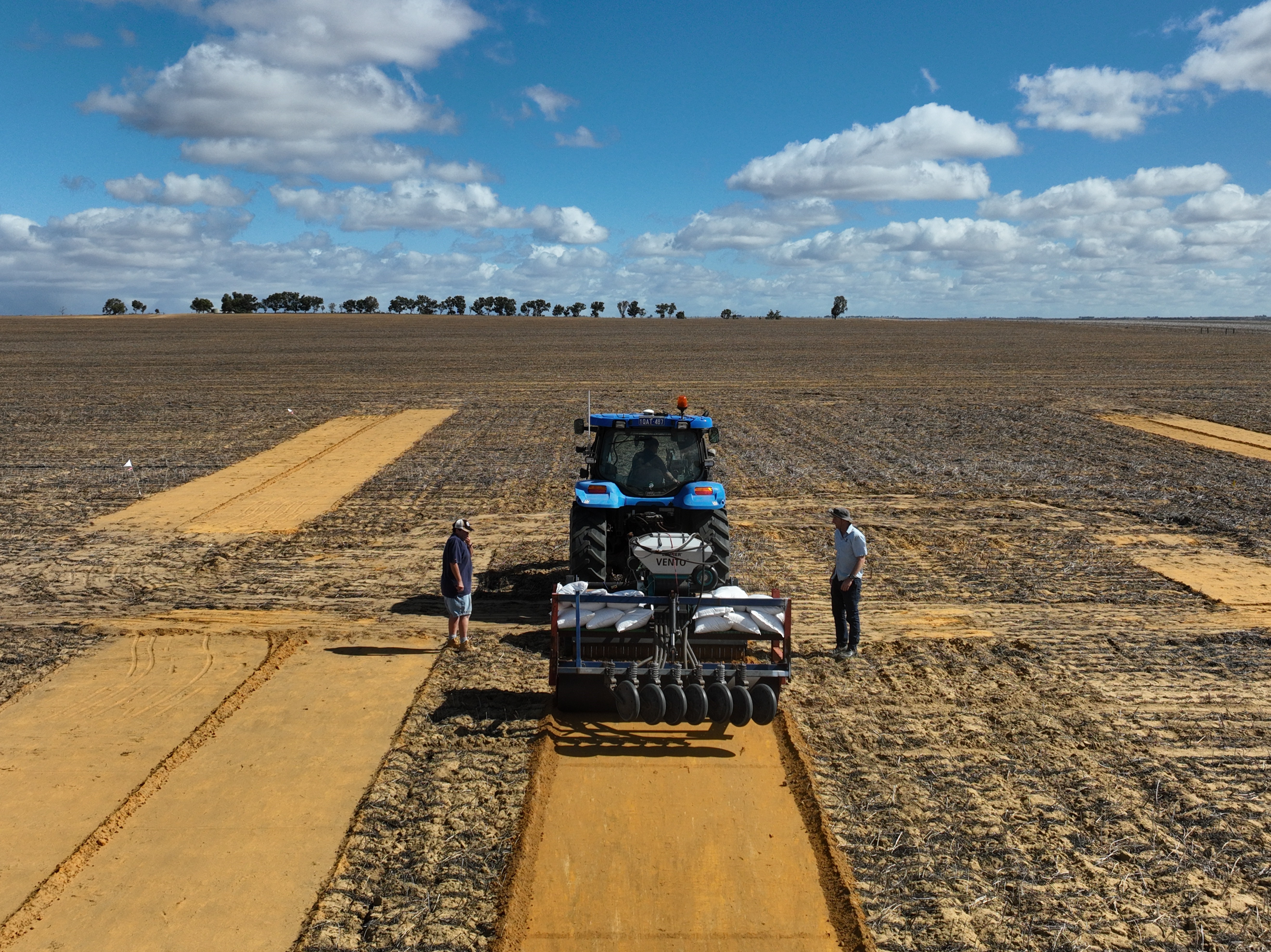
State date: 01/01/2019
Finish date: 01/06/2024
Description
The uptake of soil amelioration in Western Australia is on the rise, with more than half of growers (52%) in the grainbelt having undertaken some form of mechanical soil amelioration in 2019. A further 23% have undertaken soil amelioration by non-mechanical methods, such as spreading lime, gypsum, or clay-rich soil.
According to a GRDC report, 38% of farms nationally applied lime in 2021, with more farms in Western Australia using the technique than any other state. WA also recorded a higher percentage of soil testing compared to other states.
However, it has been found that often once that initial work has been undertaken, certain on-farm practices limit the longevity or value of the soil amelioration. For example, without the introduction of controlled traffic farming (CTF) post-amelioration, growers run the risk of re-compacting the soil they have just spent thousands of dollars fixing. Up to 60% of soil re-compaction happens in the first pass. Biotic constraints, such as weeds, or soil-borne pests and disease, can also increase on ameliorated soils and reduce the benefits, if not managed.
As a result, this project identified management changes to preserve the benefits of soil amelioration and maximise profitability. It included research into crop rotations, species choice, seedbed preparation, crop establishment, herbicide use, managing weeds, and soilborne pests and diseases, and minimising wind erosion.
This project involved research and case study sites in the Geraldton, Esperance, Albany, and Kwinana West port zones.
Research undertaken provides the following answers and increased confidence to grower decision making:
- Strategic deep tillage can lower soilborne disease and pest pressure, but the effects are often short-lived and break crops, such as canola and pulses, are critical for the continued suppression of these soilborne pathogens, thereby preserving the yield gains and profitability of soil amelioration. Similarly, weed densities can rapidly increase after soil amelioration and growers should select diverse post-soil amelioration rotations that maximise weed control. Shifting the timing of soil amelioration to a period between May and the first two weeks of June maximises productivity in periods of lower wind erosion risk. Yields on ameliorated soil in this period are equivalent to or better than those achieved on earlier sown non-ameliorated soil.
- Single pass, combined, seeding/amelioration systems maximise crop establishment and groundcover, minimising wind erosion risks while maximising productivity.
- Pre-emergent herbicides on recently ameliorated soils, that now contain reduced organic carbon, are far more active and damaging to emerging crops.
- Strategic deep tillage changes the location of pathogens throughout the soil profile, shifting them from the surface 10 cm to deeper in the profile, previously free of the disease. The initial burial of pathogen did not influence the yield gains from deep tillage. Four years after deep tillage, the influence of deep tillage on pathogens had waned, with most treatments having inoculum levels like the no-till treatment.
- In a trial to determine whether intercropping can provide rapid groundcover, increase biomass inputs, and boost productivity following soil amelioration, canola-pea, wheat-canola, wheat-lupin, and wheat-pea intercrops had lower or the same biomass and yield productivity as the monoculture wheat. The implementation of intercropping has practical challenges and a significant biological, yield, or economic benefit over monocultures is required to justify its use following soil amelioration.
Funding partner
GRDC
Project code
DAW1901-006RTX
Contact us
Wayne Parker, Senior Research Scientist
+61 (0)8 9956 8511 | Email Wayne Parker
Growers cropping soil constrained by sodicity and transient salinity in the eastern grainbelt will be able to reduce production risk and increase profitability by having access to improved information and techniques.
Start date: 01/06/2019
Finish date: 31/12/2023
Description
Sodic and alkaline (Calcareous) clay and loam soils are an important soil type in the eastern wheatbelt of Western Australia, covering approximately 2 million hectares. These soils are often highly productive where soil water is not limiting. However, in most years, the unavailability of water severely limits crop production. This is due to a combination of soil physical (aggregate instability, dispersion) and chemical constraints (sodicity, alkalinity, salinity, boron toxicity) that impede water entry, storage, and uptake.
Soil management involves both mitigation (live with the problem by managing risk) and amelioration (fixing the problem). Farmer mitigation strategies were investigated in this project.
The focus of this project has been soil amelioration, where we have investigated four themes:
- harvesting more water
- improving aggregate stability
- reducing soil evaporation
- stimulating root growth by removing physical impediments.
Each theme has elements that are novel.
Harvesting more water
Harvesting water from mounded inter-rows that drain into the seeded row has been advocated for regions with unreliable rainfall and sodic soils. This novel concept requires water shedding from mounded inter-rows using either natural sealing or waterproof membranes.
Results from 16 trial years between 2016 and 2022 have shown that mounding with a waterproof membrane can increase yields by 0.52 tonnes/hectare -1 representing a 35% yield increase. Modelling of the water harvesting system using a combination of APSIM and Hydrus also showed grain yield increases of 0.5 t/ha-1 when run with historical (1971 to 2021) rainfall data for Merredin.
To prove the concept, most experiments used plastic sheeting as the waterproof membrane. As an alternative to plastic, sprayable polymers were assessed in 2021 and 2022. The mounds with the sprayable polymer membranes increased yields in both years, irrespective of product type. Only one of the 3 polymers tested was biodegradable.
Where plastic and polymer were applied, soil water measurements showed increased water storage within the furrows. In the absence of the membranes, there was no grain yield increase in 13 of 16 mounded trial years. These findings suggest that cost effective and environmentally friendly membranes need to be developed for adoption of water harvesting in low rainfall environments.
Improving aggregate stability (Gypsum)
Gypsum (Ca2SO4.2H2O) applied at rates greater than the calculated gypsum requirement reduced dispersion, sodicity, soil pH and salinity levels in unreplicated field investigations. These results are to be expected based on the literature.
Gypsum was also applied at commercial rates (2.5–3 t/ha-1) or low rates banded in-furrow at seeding (0.05–0.1 t/ha-1). Based on 32 trial years, the average increase in grain yields due to gypsum was 0.13 t/ha-1of which only 5 trial years led to significant yield increases.
None of the gypsum treatments gave a significantly negative grain yield response. There was no difference in average grain yields between broadcast gypsum at high rates and in-furrow gypsum at low rates.
Economic analysis of the results suggests that if the small, but non-significant (P>0.05) yield increases are repeatable, the return on investment to growers would be in the order of 10:1.
Our results show that the chemistry of clay dispersion is complex, with interactions between ions (cations, anions), soil pH, mineralogy, and salinity affecting dispersion and the likely response to gypsum. In these soils, exchangeable sodium percentage (ESP) in the 0–30 cm layer was a poor predictor of crop yield compared to soil pH measured in water.
Soil response to gypsum, based on turbidimetric analysis, which measures suspended clay, shows promise as an alternative to exchangeable sodium percentage. With further research supporting these results, this test, or an evolution of, is likely to be the diagnostics analysis that will aid growers with identifying soils that will give a positive return on gypsum investment.
Reducing soil evaporation
As much as 40% of rainfall is lost through soil evaporation.
Mineral mulches (sand, gravel) reduced cumulative evaporation by 50-70% in glasshouse trials when surface was applied to a depth of 2 cm.
Field trials (16 trial years) between 2020 and 2023 gave an average grain yield increase of 0.59 t/ha-1, with the majority significantly positive (12 trial years). The largest increases in yield occurred in water-limited years.
The economics of this treatment will depend on longevity of the treatment and initial cost. Anecdotal evidence suggests that the benefits can last for more than 10 years and may also benefit the remediation of salt scalds. The initial cost of spreading was $1200 ha-1, which did not include the cost of the mineral mulch. The positive yield results are significant enough to warrant further work in this area to refine techniques/mulch type and lower cost of implementation.
Stimulating root growth through deep tillage
Previous research aimed at amelioration of sodic clay soils has focused on deep ripping with amendments (gypsum, organic matter) to achieve greater rooting depth and sustained yield improvement. This has been a reoccurring theme over the past 40 years, with mixed success and minimal adoption. Part of the reason for this is that many sodic soils have phytotoxic subsoils that, when ripped, are liable to be deposited near the surface, resulting in reduced crop yields.
Using deep tillage equipment that shattered without delving resulted in no yield increase and of the 11 trial years, 4 trial years showed significant yield reductions.
In our trials (one site over 5 years), we found no benefit from deep-placed gypsum and organic amendments (compost, straw). Further to these results are observations that rooting depth does not extend to the depth of ripping, where chemical constraints exist. It is not recommended to deep rip this soil type in a low rainfall zone.
Conclusions
This project has delivered novel systems for managing sodic soils, with substantial yield increases.
Results have been delivered through ebook (1), scientific publication (1), commissioned reports (3), national/international conferences (2), podcasts (2) industry publications (7), industry presentations (12) and field days (20). The benefit:cost ratio of this project has been assessed at 24:1 (Petersen, 2023). However, the novel nature of this research means there will be a longer path to market for some of the amelioration techniques.
Funding partner
GRDC
Project code
DAW1902-001RTX
Contact us
Stephen Davies, Principal Research Scientist
+61 (0)8 9956 8515 | Email Stephen Davies
David Hall, Grains Principal Research Scientist
+61 (0)8 9083 1142 | Email David Hall
Wayne Parker, Senior Research Scientist
+61 (0)8 9956 8511 | Email Wayne Parker
This project aimed to improve nutrient-use efficiency through soil acidity amelioration and applying fertiliser to meet agronomic need and, as a result, reduce the amount of nutrients leaching into waterways from Wheatbelt farms.
Improvements in soil pH also increase crop drought resilience by improving crop health and root depth.
Start date: 12/06/2020
Finish date: 30/05/2023
Description
Soil acidity impacts nutrient-use efficiency, and therefore agricultural productivity, through 2 main mechanisms:
- In the topsoil (0-10 cm), low soil pH (high acidity) decreases the availability of key nutrients
- In the subsurface layer (deeper than 10 cm), toxic levels of aluminium at low soil pH reduce crop root growth and access to moisture and nutrients.
Applying agricultural lime is an effective method of managing soil acidity by increasing the soil pH.
Current lime use in Western Australia agriculture is at 70% of the estimated annual requirement to address current and ongoing soil acidification.
Better nutrient-use efficiency in the topsoil reduces runoff and potential contamination of waterways, while improved crop root growth in the subsoil increases the available area of crop roots to access water and nutrients.
Precision SoilTech sampled 152 farming businesses between 2019 and 2023.
Samples were taken to the Precision SoilTech lab for pH analysis in 0.01 million calcium chloride solution (pHCa), and the results were returned to growers in a spatial and PDF/Excel format.
The spatial format retained the location information of the sample and allowed growers to view results in Google Earth, with the visual representation of colour-coded soil pH results making it easy to interpretate the results to depth and at a whole farm level.
The PDF/Excel document displayed results to depth with a corresponding 10-year lime recommendation attached to each site, which had been calculated to provide the best return on investment for spreading.
Applying lime over a 10-year timeframe allows growers to budget for the application and understand the recovery and maintenance costs involved in managing soil acidity long-term.
The department also collaborated with a leading agronomist to document growers’ long-term liming strategies and the resulting soil pH profile. Soil pH results from 30 growers were provided for this analysis. Using this historical dataset and iLime, we could understand how growers had effectively ameliorated soil acidity, as well as model future scenarios, allowing growers to compare the return on investment for different rates of lime as well as the use of soil mixing.
Results
In total, 182 farming businesses (152 by Precision SoilTech and 30 by an agronomist), located in the Avon River Basin, were sampled for soil pH from 2019-2023. A total of 40,470 soil samples were collected as part of this project.
The topsoil (0–10 cm) target pHCa is above 5.5 and critical pH is above 5, while for the subsoil depths (10–50 cm), the target pH is above 4.8 and critical pH is above 4.5.
In the topsoil, 56.5% of samples were above target, 26.9% between target and critical, and 16.6% were below the critical level.
With 44% of topsoil samples below the target pHCa of 5.5, there was an improvement on the results from a larger study conducted from 2005–2012, in which 70% of topsoils were below the target.
At a subsoil depth of 10-20 cm, 72% were above the 4.8 pHCa target, 16% between target and critical, and 12% were less than critical.
For the 20-30 cm samples, 78 were above target, 11 were between target and critical, and 11 were below critical.
Subsoil pHCa also improved compared to the 2005-2012 study, in which 50% of subsoils did not meet the target pH of 4.8.
At the deeper subsoil depth of 30-40 cm, 76% of samples were above target, 7% between target and critical, and 17% below critical, while for the 40-50 cm samples, 84% were above target, 6% were between target and critical, and 10% were below critical.
These encouraging results show the positive efforts being made by growers to ameliorate acidity in the Avon River Basin, however it is also important to recognise that the growers involved in this study are proactive and already engaged with regular soil testing. Growers are encouraged to routinely soil sample to depth to ensure an above target soil pH profile is not only achieved but maintained, long term.
Funding sources
- Department of Primary Industries and Regional Development
- Department of Water and Environmental Regulation
Contact us
Chris Gazey, Manager Soil Science and Crop Nutrition
+61 (0)8 9368 3493 | Email Chris Gazey
-
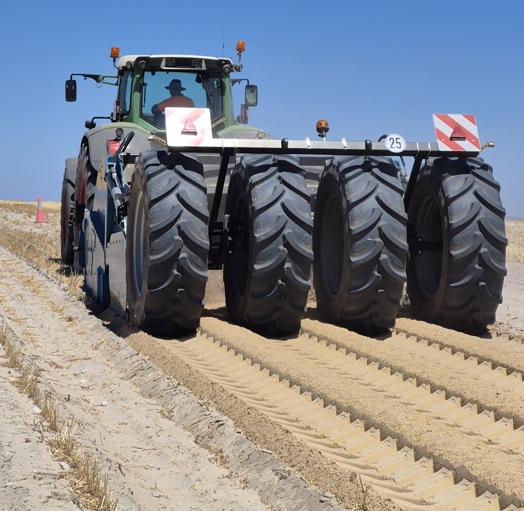 DPIRD's soil team working with growers on next generation spaders, with working depths to 1 metre, to determine value of the soil transformation
DPIRD's soil team working with growers on next generation spaders, with working depths to 1 metre, to determine value of the soil transformation -
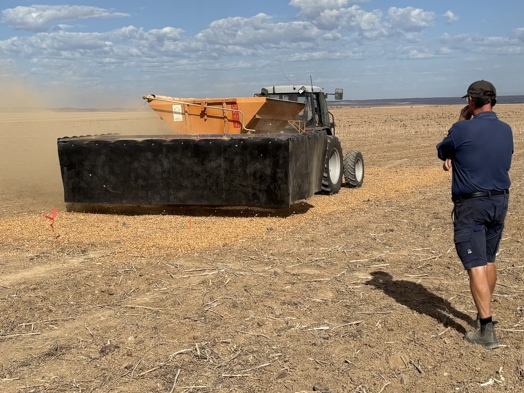 Investigating new techniques for sustainable production - applying gravel mulch to a high clay soil to determine its ability to reduce evaporation
Investigating new techniques for sustainable production - applying gravel mulch to a high clay soil to determine its ability to reduce evaporation

